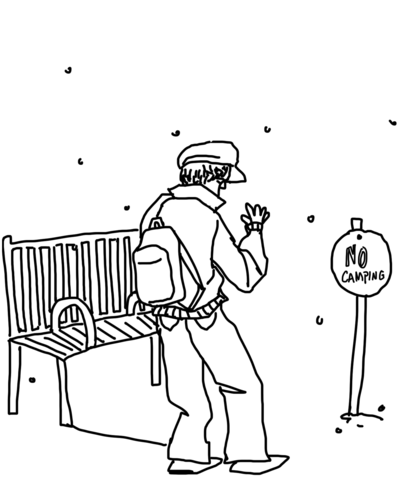Examples of hostile architecture are all over urban areas; benches with dividers indicating where individuals should sit, front stoops with arrays of metallic spikes, even places for sitting replaced by inclined surfaces for leaning instead. This architecture exists in our parks, sidewalks and transportation terminals and serve a dark, questionable purpose. What they all have in common is the passive implication that people can only use public spaces in certain ways under threat of pain or discomfort.
The presence of hostile architecture is to deter the homeless population from existing in public spaces. In theory, a person cannot sleep on a park bench if there are physical barriers. Hostile architecture is a step further from sit and lie ordinances, which are selectively enforced against homeless people and essentially criminalize homelessness. But where law enforcement fail in actively policing the homeless, hostile architecture makes the act impossible, or at least very uncomfortable.
This architecture style does not address the root of the problem. What causes homelessness? It’s a complex issue involving multiple factors, such as health, education, socioeconomic upbringing, race, substance abuse and sometimes plain bad luck. However, no one chooses to not be homeless because the flat surfaces of a city have spikes or intrusive ridges. Hostile architecture does not solve homelessness, but pushes it into the gutters away from our field of vision, while turning ledges and surfaces into unappealing eyesores. Although certainly ugly, the fundamental evil of hostile architecture is it makes citiscapes unlivable for the most vulnerable.
Hostile architecture does not just affect homeless people. Uncomfortable benches and chairs are challenging to use or inaccessible to people with disabilities, the elderly and children.
Another reason hostile architecture is implemented is to prevent using the space for skateboarding. However, the need for accessible surroundings is more important than the desire to not see skateboarders in the community. The damage skateboarders inflict on public spaces is also not serious enough to warrant restricting the space for this reason.
Pieces such as “the Camden Bench” which is a misshapen block with random slants, hard edges, and no back support were designed with the explicit purpose of not promoting “anti-social behavior” or in other words, anything but sitting for a few minutes. The city of London could not remove all public seating, but also did not want these public areas to become “hangout spots” for the homeless, rowdy youth or anyone seen as disruptive. The Camden Bench allows people to sit, but not for very long; it’s not terribly enjoyable but still serves its limited purpose for the agenda of the city.
The officials and planners signing off on these installations are admitting public spaces are not as public as we were led to believe. People are expected to give up some accessibility in public spaces for the sake of appearances for the policymakers. But if a stoop needs spikes to keep people from sleeping on it, there’s probably a larger, untreated illness of this broken society that spikes are not equipped to address.
Poverty is why the homeless are the primary victims of hostile architecture. If homelessness is criminalized but do nothing to remedy the root cause, it’s a slippery slope to criminalizing poverty. And when socioeconomic circumstances are made illegal, it gives law enforcement and city plannersunrestricted ability to make public spaces and services less accessible to the have-nots.
It’s not just about spikes on windowsills, it’s a symptom of a larger issue. The worst solutions are being implemented without pause as to who really wins in the end. Hostile architecture is not a necessary evil or a brilliant alternative; it is only an unempathetic inconveniece for an already burdened population.
– Zach Ienatsch is a journalism senior
Categories:
Hostile architecture is ineffective and unethical
March 1, 2018

Illustration by Kennedy Swift | Staff Illustrator
0
Donate to The University Star
Your donation will support the student journalists of Texas State University. Your contribution will allow us to purchase equipment and cover our annual website hosting costs.
More to Discover





